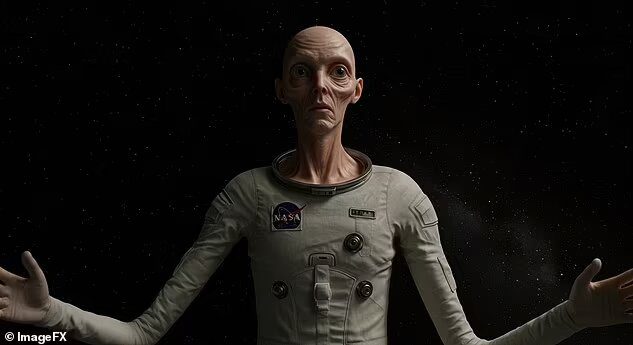Looking back at the evolution of our species, it is apparent that humans have reached the final stages of a long process of advancement. However, many scientists believe that human evolution is merely at its starting point. With advances in technology, space travel, and climate change, the world around us is changing faster than ever— and experts believe that humanity will evolve alongside it. According to a report from Dailymail, scientists have utilized Google’s ImageFX AI tool to visualize the evolution of the human species.
Experts predict that future humans will have a significantly different appearance. The average person is expected to have darker skin and resemble individuals from culturally blended regions such as Mauritius or Brazil. Furthermore, encouraging news for everyone is that experts suggest humans in 3025 may be more attractive than we are today.
How Will Humans Evolve by 3025?
Shorter Stature
In the past, the most significant driving factor of evolution was the survival of offspring before they had a chance to reproduce and pass on their genes. However, modern medicine has increasingly allowed many people to live long enough to have children. This means that a different selection pressure will influence which genes contribute to the human gene pool.

Professor Mark Thomas (an evolutionary geneticist at UCL) shared with Dailymail: “Previously, this was often based on the survival difficulty of offspring, but now it seems that extended lifespans are driving evolution rather than the number of children born.” Essentially, this means that those with more children will have a greater chance of passing on their genes to future generations. This suggests that the evolution of shorter stature may be on the horizon. Although Professor Thomas doesn’t definitively state that this is “one of many hypotheses,” many have argued that shorter stature is correlated with fertility.
Reaching a point of shorter stature allows for more offspring to be produced throughout a lifespan, but this may still lead to a reduction in size. Professor Thomas noted: “This is one of the many hypotheses being put forward to explain why you see shorter people living in many places globally. The life expectancy of shorter individuals is much shorter in extreme climates, which has led to shorter stature being linked to reproductive success.”
If shorter people have more children, the genes contributing to shorter stature may also increase in the population. However, Professor Thomas emphasizes that this idea has not yet been proven in human studies, meaning that this relationship might not hold true outside specific environments.
More Attractive
As the population of humans decreases, the most significant driving factor of evolution will be the number of offspring one can produce. Interestingly, this underlying dynamic could make humans more appealing. Professor Thomas stated: “The natural status of offspring is to be the chosen one. However, when you have the potential to produce more offspring, as we see in many places worldwide, they will likely be the chosen and selected ones.”

As society becomes more cosmopolitan and individuals increasingly have the ability to select their traits, the pressure for selection may become more pronounced. Professor Thomas stated: “Fortunately, we are transitioning into a world where selection for specific traits is becoming normalized. This may relate to factors such as wealth, success, physical appearance, or other attributes, leading to a potential increase in the genetic diversity of the population.”
As humans evolve to become more appealing, it is expected that the attributes of future individuals will significantly differ from those of the current population, as they will inherit a broader range of genetic traits. However, at the population level, this may lead to less diversity.
Professor Hodgson stated: “Looking at appearances, when you see more individuals with many common traits, there may be less diversity. If we consider how certain traits can vary depending on the population—such as skin color—most individuals will likely have darker skin, or at least none will have very pale skin.” Professor Thomas suggested that a good reference point would be the current populations of Brazil or Mauritius, where many ethnic groups have blended together over the years.
Reduced Brain Size
Professor Robert Brooks (an evolutionary biologist at the University of New South Wales, Sydney) told MailOnline that he predicts human brain size will shrink over time. Professor Brooks theorizes that as machines become more capable of processing information more efficiently than humans, the need for larger brains will diminish.

According to The Conversation, evolutionary biologist Nicholas Longrich (from Bath University) has compared the future development of humans to that of a domesticated species. Longrich wrote: “It could be argued that we are evolving into a domesticated species, but ironically, it is because we are domesticating ourselves.” He continued: “The brain volume has decreased by 24% in domesticated species; for dogs, this number is 26%; for sheep, it is 30%. This indicates a significant ability to adapt. It’s possible that we are becoming more domesticated, just like a domesticated species, which has been artificially selected into our own kind, just as it has with them.”
Potential to Select Distinct Traits
Emerging technologies may allow humans to shape their own evolutionary paths more effectively. Professor Hodgson noted: “I am curious whether evolution can manifest naturally in the distant future. Currently, we have technologies that enable targeted gene editing using CRISPR-Cas9. This allows us to modify specific genes at will.”
Although Professor Hodgson indicates that most scientists today consider this behavior to be unethical, future generations may not be as strict. Some companies are already offering ‘designer baby’ services in the US, claiming to help parents select traits like height, intelligence, and attractiveness. If these technologies are permitted to spread without regulation, the traits inherited could result in a more uniform population.

Professor Hodgson stated: “In the distant future, you may see changes that are quite significant and could occur on the scale of entire species.” Utilizing technologies like CRISPR-Cas9 allows scientists to cut and paste DNA segments, enabling humans to acquire new genetic traits from different species. For example, individuals could choose to have darker skin with higher melanin levels to help protect against harmful UV rays.
Fashion and cultural trends will also influence the appearance of future humans as technology allows individuals to select more about their physical forms. Professor John Hawks (a paleoanthropologist at the University of Wisconsin-Madison) told MailOnline: “If we look to the future, these changes in culture and technology will likely be more powerful than changes in evolution across humanity. Many of these changes will likely influence appearance: you might consider various skin colors and all kinds of aesthetic adjustments, as well as methods that will likely combine aesthetics with technology.”





















